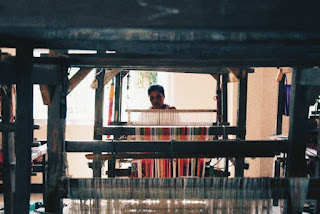THE INABEL OF ILOCOS: REGION'S PRIDE AND TREASURE
Through the years, as what we can observe in our country, the number of weavers and pocket communities that uphold the tradition of weaving get smaller and smaller and consequently, more women are losing their source of livelihood. With this, the production and the usage of traditionally weaved cloths were also rapidly declining, and inabel cloth weaving has no exemption from this.
The inabel weaving is one of the prides of the Ilocos region in the Philippines. “Abel” is the Ilocano word for weave, and “inabel” can be interpreted to mean any kind of woven fabric. However, to the Ilocanos, the inabel is particularly used to refer to textile that is distinctly Ilocano in origin.
This type of fabric is made of cotton that are usually plain or patterned. The cloth is well known and loved by the locals for its softness,beautiful design and its durability.
Ilocos' traditional weavers use hardwood pedal looms, in creating different design techniques.
Behind the beautiful designs and patterns, it also convey some meaning. Like for example the binakul pattern. It is a dizzying pattern that is meant to ward off and distract evil spirits, protecting the wearer.
Other patterns may also include the multi-heddle design technique, the pinilian or brocade weave, the suk-suk or discontinuous supplementary weft technique, and the ikat tie-dye technique.
The same with other forms of handweaving in the country, the process of creating inabel is intricate and labor-intensive. It takes a lot of effort and patience in creating such masterpiece. Popular patterns to locals include cat's paws, fans, stars, and windows.
The traditional process of weaving abel cloth starts with preparing the cotton, from picking cotton balls, removing seeds, pounding or beating, twisting using a spindle, and winding the cotton yarn into the skeiner. The skeined yarn is then brushed to make it glossy and durable before it is wound to a bamboo spool.
Once the yarn is ready, it’s time to prepare the loom.
The weaver winds the spool yarn into the warping reel. The warp yarn is then wound into the warp beam rod. Next comes heddling, in which the warp yarn is inserted through the eye of the heddle using a weaving hook. After that, the weaver inserts the warp yarn through the spaces of the reed and “dresses” the loom by tying the heddles behind the beater. Here, the weaving of the cloth commence.
Plain weaves are preferably the most commonly produced inabel. These are used for everything, from hand towels and placemats to blankets and dress material.
In Ilocos, it is common for an inabel to be used as material for everyday household items such as curtains, tablecloths, bath towels, table runners, bed linen, bags, and even mosquito nets.
In order to preserve and prolong this traditional type of weaving, the younger generation of Ilocanos are being encouraged to keep the tradition of inabel alive. In the town of Pinili in Ilocos Norte, the local government has been offering basic weaving courses to all interested individuals since 2018. The lessons are presided by Magdalena Gamayo, one of the country’s National Living Treasures.
Gamayo was awarded the “Gawad Manlilikha ng Bayan” by the National Commision for Culture and the Arts in 2012 for her mastery in abel weaving. The award is the highest honor given to craftsmen, artisans, folk artists, and culture-bearers in our country.
Inabel cloth weaving is an example of a treasure, that our country needs to preserve and prolong for our next generation to keep our country's traditional way of weaving alive over the years.
Once the yarn is ready, it’s time to prepare the loom.
The weaver winds the spool yarn into the warping reel. The warp yarn is then wound into the warp beam rod. Next comes heddling, in which the warp yarn is inserted through the eye of the heddle using a weaving hook. After that, the weaver inserts the warp yarn through the spaces of the reed and “dresses” the loom by tying the heddles behind the beater. Here, the weaving of the cloth commence.
Plain weaves are preferably the most commonly produced inabel. These are used for everything, from hand towels and placemats to blankets and dress material.
In Ilocos, it is common for an inabel to be used as material for everyday household items such as curtains, tablecloths, bath towels, table runners, bed linen, bags, and even mosquito nets.
In order to preserve and prolong this traditional type of weaving, the younger generation of Ilocanos are being encouraged to keep the tradition of inabel alive. In the town of Pinili in Ilocos Norte, the local government has been offering basic weaving courses to all interested individuals since 2018. The lessons are presided by Magdalena Gamayo, one of the country’s National Living Treasures.
Gamayo was awarded the “Gawad Manlilikha ng Bayan” by the National Commision for Culture and the Arts in 2012 for her mastery in abel weaving. The award is the highest honor given to craftsmen, artisans, folk artists, and culture-bearers in our country.
Inabel cloth weaving is an example of a treasure, that our country needs to preserve and prolong for our next generation to keep our country's traditional way of weaving alive over the years.


Comments
Post a Comment